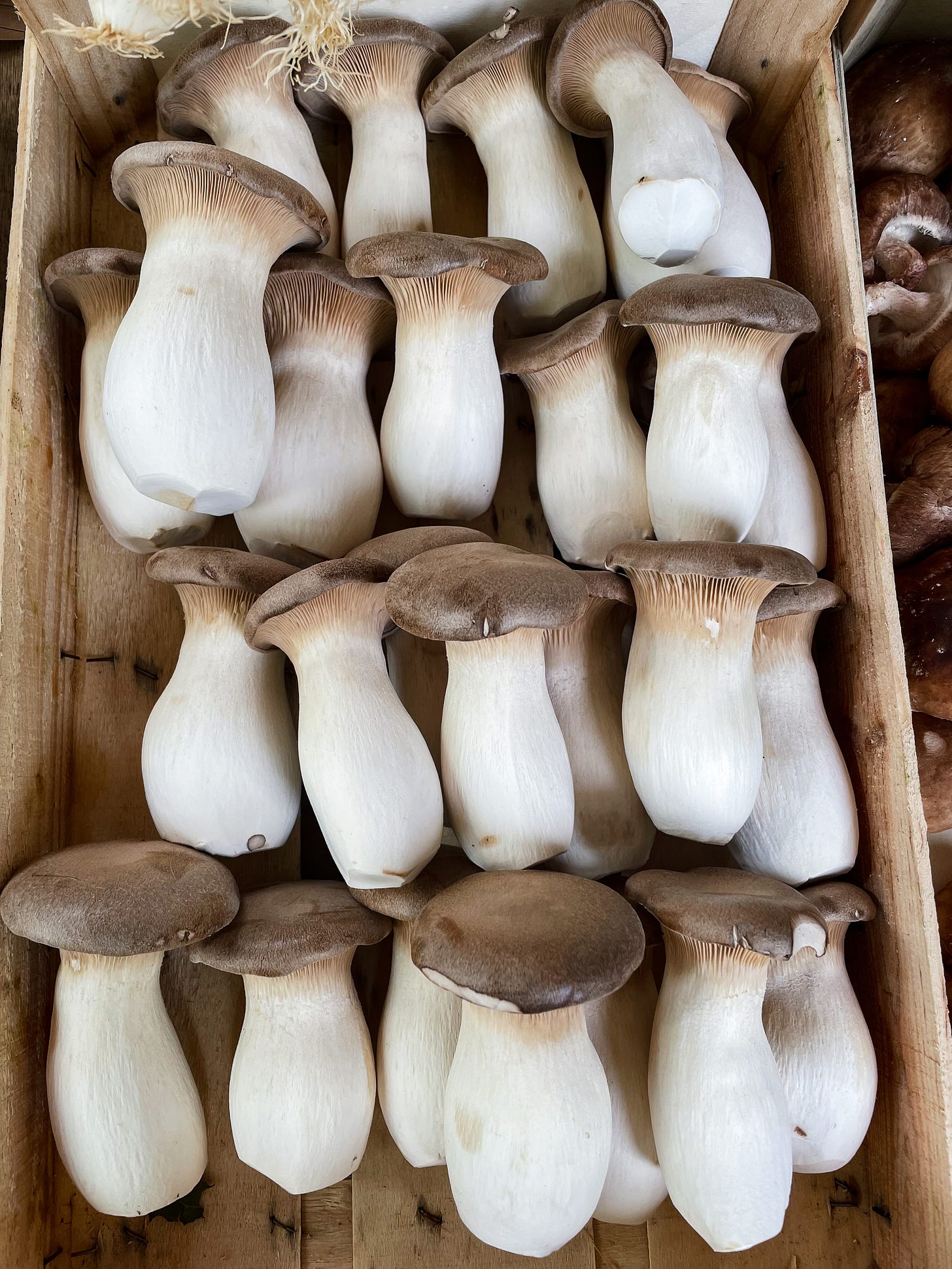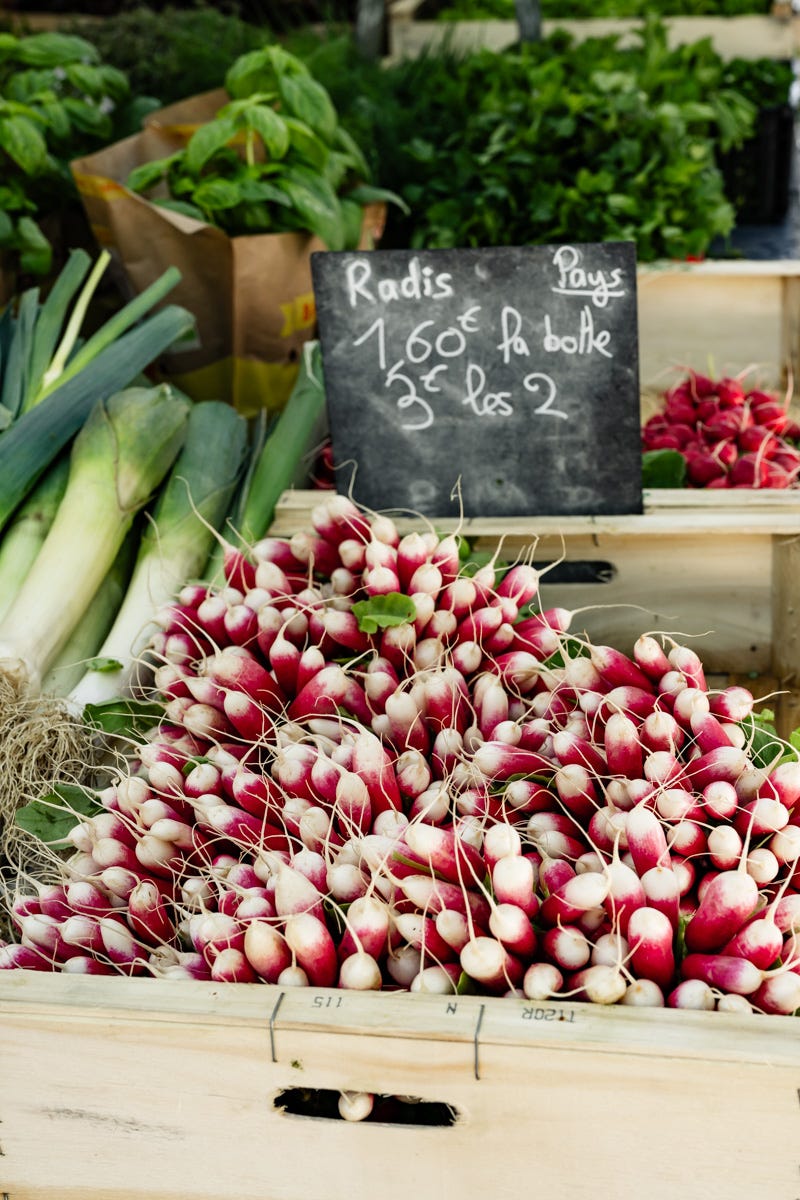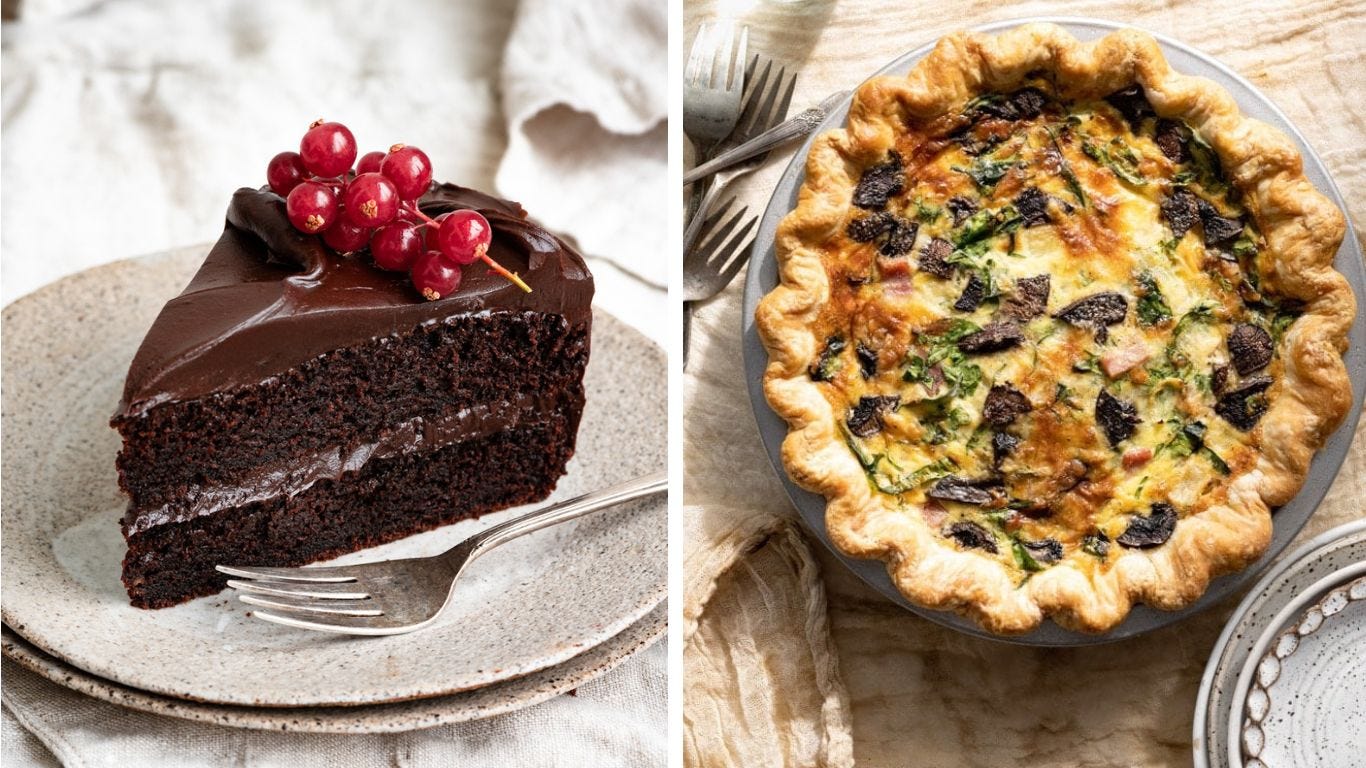All bundled up with a long wool coat, gloves, a Parisian tucked scarf, with several cloth tote bags on my shoulder, its Sunday and I’m headed to the market. Grocery shopping outdoors in January alongside the river Garonne amongst a bustle of people, dogs, and food vendors is a far cry from the fluorescent lit aisles of a Chicago Whole Foods.
Snacking on a fresh pain aux raisin as I muster up the courage to order in French..bacon by tranches, cheese by width, and seafood in grams. A few nods, a short explanation of flavor pairings to recipe suggestions, Merci, Bon Weekend, a little smile of victory. Interactions beginning with Madame and Monsieur, food displayed without plastic, breathing in cold fresh air to a background hum of shoppers truly makes market day a beloved activity.
How did I get to the market? I took a short bus ride from my house and walked the last 3/4 of a mile. No traffic, no parking, no shopping cart, just me and a few bags. I’m only buying what I can comfortably carry home on my shoulders without any pre-packaged or frozen items.
Yes, there are grocery stores, but the Sunday market in France is a social outing where fresh and local food is celebrated. No one is stuffing a trunk full of sodas or cereals, pizzas or nuggets, fighting over parking spots and grumbling about how many lanes are open.
In contrast, patrons are not rushing, but rather enjoying selecting their items, buying just what they need to cook a few meals. They’re deep in conversations over their favorite bread, how to enjoy artichokes, having lunch from a vendor sipping a glass of local wine while the wind whips under their tablecloth. I’ve found my happy place.
What is ‘Fresh Everyday’?
The concept of Fresh Everyday centers around having less waste, buying what you need when you need it, and using quality seasonal ingredients. This leads to frequent smaller shopping trips, consuming what you purchase, and cooking most of your meals.
French refrigerators are typically much smaller than American ones because they don't need to hold a weeks' worth of food. Mine is probably half the size of the fridge I had in the states and the freezer has about as much capacity as two small shoeboxes. And no, I don’t have an icemaker.
There’s a few drawers for pantry items and I keep my eggs, garlic, and oil on the counter. If you’ve lived in a NYC apartment you’re probably nodding your head. Even my Chicago apartment had twice as much pantry room as my current French home. But, many French city houses are outfitted this way, offering less space thus encouraging more thoughtful food habits.
In the US, most households have a dedicated pantry, a few additional cabinets for food, a large fridge and freezer, and maybe even more food kept in a garage. Growing up, I knew my parent’s were well supplied if a zombie apocalypse were to break out. But, even in my own attempt of trying to ‘stock up’, keep lots of items on hand, plan meals 4-5 days in advance, I found many things are forgotten, life happens and the food I planned to eat goes bad before I get a chance to use it. For me, throwing fresh ingredients in the trash is just not an option.
Since moving to France, I’ve found a greater sense of joy in being more mindful and strategic in my food selection. By only focusing on food needs for a couple of day’s, I don’t get bored with what I have and find it easier to be less wasteful.
A French Style Shopping Schedule
Adopting French grocery habits may seem more time-consuming than one big grocery haul, but its so much more than just replenishing the fridge. Visiting local shops and chatting with vendors is a part of daily French life that focuses on community and valuing the food we eat.
Even if you’re not sure what to buy fresh, most of the time the offerings will dictate the menu for you. I often have an idea of what I want to cook, but let my meals be influenced by what looks best at the market that day. For instance, I had planned to make shrimp pasta a few weeks back, but all the shrimp was sold out when I arrived. Pivot to roasted butternut squash pasta thanks to the abundance at the vegetable stand.
Here’s a shopping schedule I’ve adopted based on the market’s in Bordeaux.
Daily - Bakery
Boulangerie for baguettes or other fresh bread purchased in the morning to pair with lunch and dinner. Since bread stales quickly a daily baguette is a must and even the artisanal traditional options in France are only 1.20 euro.
Pastries are best consumed either at a small table with a cappuccino or immediately upon purchase, leaning slightly forward to prevent crumbs from covering your scarf.
Most almond croissants are available later in the week to use up the unsold plain croissants.
If you find yourself in Bordeaux, make sure to order a ‘chocolatine’ and not a ‘pain au chocolat’, to avoid a bakery faux pas.
Twice Weekly - Outdoor Market
Smaller weekday market plus the main shopping day on Saturday or Sunday.
The main market visit is for socializing, chatting with vendors, eating lunch, and purchasing the bulk of your items.
Lunch at the market consists of everything from fresh oysters to steak, galettes to salads, hot soup and sandwiches, and an array of cheeses.
The second market day, usually at a smaller neighbourhood setup, stop by to grab ingredients for weekend meals.
Replenish fresh produce on both visits to ensure nothing sits in the fridge too long.
Weekly - Specialty Shops
Pop in as needed, to the fromagerie (cheese), poissonnerie (fishmonger), boucherie (butcher), rôtisseur (rotisserie chicken, pork, etc,) or wine shop.
Plein air, free range eggs from local farms, no need to refrigerate.
l'Épicerie for an array of spices, olive oil shops, and tinned fish stores.
All of these options are also available at the outdoor markets, but the specialty shops are open everyday.
Monthly - Staples at the Supermarché
Pantry staples to include beans, rice, cornichons, spices, vinegars, baking supplies, etc.
How to Incorporate French Shopping Habits
Take a few canvas tote bags or small grocery bag on wheels the next time you go shopping, try to only purchase what you can carry.
Start with twice-weekly
Try to designate two days a week for grocery shopping. Grab just enough ingredients to make meals for about three days.
I know this sounds insane if you’re a TJ’s fan, but fresh pasta tastes way better than microwaved frozen noodles.
Plan around freshness
By most of your veggies, fruits, and proteins all fresh, not packaged or from a can.
With too many options, a lot of food isn’t consumed. Utilizing items that will spoil first may make meals simpler, eliminating the need to answer the question of ‘what are we having for dinner?’. My husband knows when I test a recipe 3-4 times, that’s what we’ll be eating all week.
Buy smaller quantities if you can
If you have lots of people eating in your kitchen on a daily basis, our grocery hauls will look quite different. Rather than risking hangry outbursts from lack of food, look more at what you throw away or how long something has been sitting in your fridge or freezer. Then, make a note to buy those items less often or use them first next time.
Building relationships with local vendors
Whether you live in a small town or a big city, unless you’re growing food yourself, someone is selling it to you. This is a great opportunity to learn, ask questions and be curious about what you’re consuming.
Ask the vendor at your local market or the person behind the counter for suggestions, tell them what you like, what type of recipe you want to make and ask what ingredients are best to try.
Make ‘Fromage Fort’ with Leftover Cheese
Uneaten cheese may be a highly uncommon occurrence, but sometimes there’s a little leftover mascarpone in a tub or a chunk of cheese forgotten from a party that just needs a purpose. Think of fromage fort like a French cheeseball or hodgepodge cracker spread that cleans out the fridge, satisfying an afternoon snack craving.
**Warning…I recommend postponing all erotic activity after consuming ‘fromage fort’. Garlic, chives and cheese, does not equal a favorable make-out session.
Ingredients
200 grams hard and medium cheese, rinds removed, cut into small cubes
50 grams soft cheese (mascarpone, chèvre - goat cheese, or cream cheese)
1 tablespoon salted butter
1 garlic clove, peeled and minced
60 grams (1/4 cup) dry white wine
freshly ground black pepper
pinch of fine or flaky sea salt
1 -2 tablespoons minced fresh herbs (parsley, dill, tarragon) and/or chives
For the Fromage Fort pictured I used leftovers of:
hard cheese mixture of tomme chèvre brebis and petit basque
soft cheese mixture of mostly langres and a tablespoon of mascarpone
chives and dill
topped with a sprinkle of sesame seeds
Instructions
Place the cheeses into a food processor, add the butter, garlic, and wine. Process until smooth. It may look like cottage cheese at first, depending on what cheese you’re using. If its super chunky add a little more soft cheese and blend again.
Once smooth, add your pepper, salt, herbs and chives. Blend to distribute, then give it a taste. Season to your liking.
Transfer to a small bowl, serve with an extra topping of chopped herbs and chives, with a sprinkle of sesame seeds. Spread on crackers, toasted baguette slices, add to an omelette, melt on fries or baked potatoes. Pair with a sparkling or dry white wine.
Storage
Place fromage fort in an air tight container and refrigerate for up to 5 days. The flavors of the cheese medley will develop over time.
New Bakes on Two Cups Flour
Easy homemade fluffy buttermilk biscuits are perfect for a breakfast style sandwich.
Buttermilk bacon and cheese scones packed with sharp cheddar, nutty gruyere, and hearty chunks of thick bacon.
Indulge in a rich, moist chocolate rum cake infused with spiced rum with layers of dark chocolate ganache buttercream frosting.
Ham and cheese spinach quiche has a flaky pie crust with a savory egg custard filling full of ham, gruyere cheese, spinach, and mushrooms.










Lovely atmospheric post. I lived in France for a couple of years and then tried to transfer my French buying habits to England. It resulted in daily ransacking of the eponymous ‘middle of Lidl’, a house full of tat and a fridge full of reduced food. I’ve had to move back to a weekly shop unfortunately but miss those market days.
I love living this way in Italy. Wonderful summary.